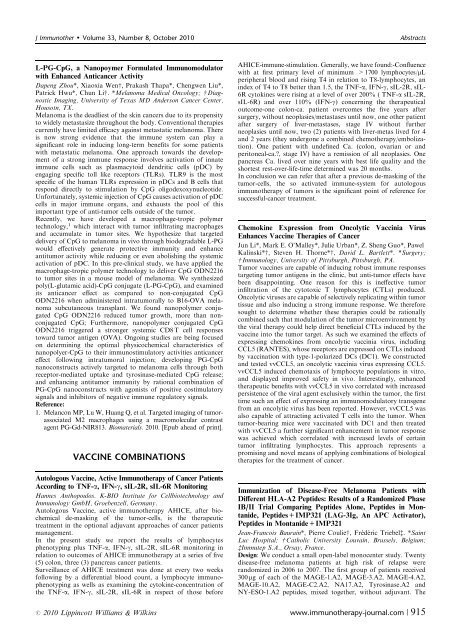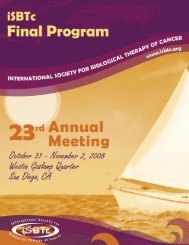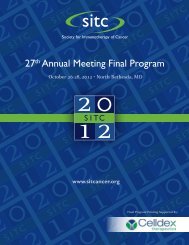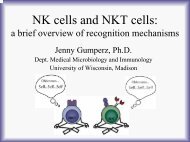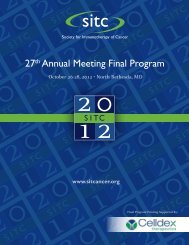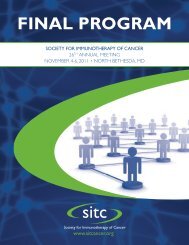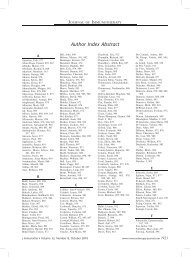Abstracts for the 25th Annual Scientific Meeting of the International ...
Abstracts for the 25th Annual Scientific Meeting of the International ...
Abstracts for the 25th Annual Scientific Meeting of the International ...
Create successful ePaper yourself
Turn your PDF publications into a flip-book with our unique Google optimized e-Paper software.
J Immuno<strong>the</strong>r Volume 33, Number 8, October 2010<br />
<strong>Abstracts</strong><br />
L-PG-CpG, a Nanopoymer Formulated Immunomodulator<br />
with Enhanced Anticancer Activity<br />
Dapeng Zhou*, Xiaoxia Wenw, Prakash Thapa*, Chengwen Liu*,<br />
Patrick Hwu*, Chun Liw. *Melanoma Medical Oncology; w Diagnostic<br />
Imaging, University <strong>of</strong> Texas MD Anderson Cancer Center,<br />
Housotn, TX.<br />
Melanoma is <strong>the</strong> deadliest <strong>of</strong> <strong>the</strong> skin cancers due to its propensity<br />
to widely metastasize throughout <strong>the</strong> body. Conventional <strong>the</strong>rapies<br />
currently have limited efficacy against metastatic melanoma. There<br />
is now strong evidence that <strong>the</strong> immune system can play a<br />
significant role in inducing long-term benefits <strong>for</strong> some patients<br />
with metastatic melanoma. One approach towards <strong>the</strong> development<br />
<strong>of</strong> a strong immune response involves activation <strong>of</strong> innate<br />
immune cells such as plasmacytoid dendritic cells (pDC) by<br />
engaging specific toll like receptors (TLRs). TLR9 is <strong>the</strong> most<br />
specific <strong>of</strong> <strong>the</strong> human TLRs expression in pDCs and B cells that<br />
respond directly to stimulation by CpG oligodexoxynucleotide.<br />
Un<strong>for</strong>tunately, systemic injection <strong>of</strong> CpG causes activation <strong>of</strong> pDC<br />
cells in major immune organs, and exhausts <strong>the</strong> pool <strong>of</strong> this<br />
important type <strong>of</strong> anti-tumor cells outside <strong>of</strong> <strong>the</strong> tumor.<br />
Recently, we have developed a macrophage-tropic polymer<br />
technology, 1 which interact with tumor infiltrating macrophages<br />
and accumulate in tumor sites. We hypo<strong>the</strong>size that targeted<br />
delivery <strong>of</strong> CpG to melanoma in vivo through biodegradable L-PG<br />
would effectively generate protective immunity and enhance<br />
antitumor activity while reducing or even abolishing <strong>the</strong> systemic<br />
activation <strong>of</strong> pDC. In this pre-clinical study, we have applied <strong>the</strong><br />
macrophage-tropic polymer technology to deliver CpG ODN2216<br />
to tumor sites in a mouse model <strong>of</strong> melanoma. We syn<strong>the</strong>sized<br />
poly(L-glutamic acid)-CpG conjugate (L-PG-CpG), and examined<br />
its anticancer effect as compared to non-conjugated CpG<br />
ODN2216 when administered intratumorally to B16-OVA melanoma<br />
subcutaneous transplant. We found nanopolymer conjugated<br />
CpG ODN2216 reduced tumor growth, more than nonconjugated<br />
CpG; Fur<strong>the</strong>rmore, nanopolymer conjugated CpG<br />
ODN2216 triggered a stronger systemic CD8 T cell responses<br />
toward tumor antigen (OVA). Ongoing studies are being focused<br />
on determining <strong>the</strong> optimal physicochemical characteristics <strong>of</strong><br />
nanopolyer-CpG to <strong>the</strong>ir immunostimulatory activities anticancer<br />
effect following intratumoral injection; developing PG-CpG<br />
nanoconstructs actively targeted to melanoma cells through both<br />
receptor-mediated uptake and tyrosinase-mediated CpG release;<br />
and enhancing antitumor immunity by rational combination <strong>of</strong><br />
PG-CpG nanoconstructs with agonists <strong>of</strong> positive costimulatory<br />
signals and inhibitors <strong>of</strong> negative immune regulatory signals.<br />
Reference:<br />
1. Melancon MP, Lu W, Huang Q, et al. Targeted imaging <strong>of</strong> tumorassociated<br />
M2 macrophages using a macromolecular contrast<br />
agent PG-Gd-NIR813. Biomaterials. 2010. [Epub ahead <strong>of</strong> print].<br />
VACCINE COMBINATIONS<br />
Autologous Vaccine, Active Immuno<strong>the</strong>rapy <strong>of</strong> Cancer Patients<br />
AccordingtoTNF-a, IFN-g, sIL-2R, sIL-6R Monitoring<br />
Hannes Anthopoulos. K-BIO Institute <strong>for</strong> Cellbiotechnology and<br />
Immunology GmbH, Groebenzell, Germany.<br />
Autologous Vaccine, active immuno<strong>the</strong>rapy AHICE, after biochemical<br />
de-masking <strong>of</strong> <strong>the</strong> tumor-cells, is <strong>the</strong> <strong>the</strong>rapeutic<br />
treatment in <strong>the</strong> optional adjuvant approaches <strong>of</strong> cancer patients<br />
management.<br />
In <strong>the</strong> present study we report <strong>the</strong> results <strong>of</strong> lymphocytes<br />
phenotyping plus TNF-a, IFN-g, sIL-2R, sIL-6R monitoring in<br />
relation to outcomes <strong>of</strong> AHICE immuno<strong>the</strong>rapy at a series <strong>of</strong> five<br />
(5) colon, three (3) pancreas cancer patients.<br />
Surveillance <strong>of</strong> AHICE treatment was done at every two weeks<br />
following by a differential blood count, a lymphocyte immunophenotyping<br />
as wells as examining <strong>the</strong> cytokine-concentration <strong>of</strong><br />
<strong>the</strong> TNF-a, IFN-g, sIL-2R, sIL-6R in respect <strong>of</strong> those be<strong>for</strong>e<br />
AHICE-immune-stimulation. Generally, we have found:-Confluence<br />
with at first primary level <strong>of</strong> minimum >1700 lymphocytes/mL<br />
peripheral blood and rising T4 in relation to T8-lymphocytes, an<br />
index <strong>of</strong> T4 to T8 better than 1.5, <strong>the</strong> TNF-a, IFN-g, sIL-2R, sIL-<br />
6R cytokines were rising at a level <strong>of</strong> over 200% ( TNF-a sIL-2R,<br />
sIL-6R) and over 110% (IFN-g) concerning <strong>the</strong> <strong>the</strong>rapeutical<br />
outcome-one colon-ca. patient overcomes <strong>the</strong> five years after<br />
surgery, without neoplasies/metastases until now, one o<strong>the</strong>r patient<br />
after surgery <strong>of</strong> liver-metastases, stage IV without fur<strong>the</strong>r<br />
neoplasies until now, two (2) patients with liver-metas lived <strong>for</strong> 4<br />
and 2 years (<strong>the</strong>y undergone a combined chemo<strong>the</strong>rapy/embolization).<br />
One patient with undefined Ca. (colon, ovarian or and<br />
peritoneal-ca.?, stage IV) have a remission <strong>of</strong> all neoplasies. One<br />
pancreas Ca. lived over nine years with best life quality and <strong>the</strong><br />
shortest rest-over-life-time determined was 20 months.<br />
In conclusion we can refer that after a previous de-masking <strong>of</strong> <strong>the</strong><br />
tumor-cells, <strong>the</strong> so activated immune-system <strong>for</strong> autologous<br />
immuno<strong>the</strong>rapy <strong>of</strong> tumors is <strong>the</strong> significant point <strong>of</strong> reference <strong>for</strong><br />
successful-cancer treatment.<br />
Chemokine Expression from Oncolytic Vaccinia Virus<br />
Enhances Vaccine Therapies <strong>of</strong> Cancer<br />
Jun Li*, Mark E. O’Malley*, Julie Urban*, Z. Sheng Guo*, Pawel<br />
Kalinski*w, Steven H. Thorne*w, David L. Bartlett*. *Surgery;<br />
w Immunology, University <strong>of</strong> Pittsburgh, Pittsburgh, PA.<br />
Tumor vaccines are capable <strong>of</strong> inducing robust immune responses<br />
targeting tumor antigens in <strong>the</strong> clinic, but anti-tumor effects have<br />
been disappointing. One reason <strong>for</strong> this is ineffective tumor<br />
infiltration <strong>of</strong> <strong>the</strong> cytotoxic T lymphocytes (CTLs) produced.<br />
Oncolytic viruses are capable <strong>of</strong> selectively replicating within tumor<br />
tissue and also inducing a strong immune response. We <strong>the</strong>re<strong>for</strong>e<br />
sought to determine whe<strong>the</strong>r <strong>the</strong>se <strong>the</strong>rapies could be rationally<br />
combined such that modulation <strong>of</strong> <strong>the</strong> tumor microenvironment by<br />
<strong>the</strong> viral <strong>the</strong>rapy could help direct beneficial CTLs induced by <strong>the</strong><br />
vaccine into <strong>the</strong> tumor target. As such we examined <strong>the</strong> effects <strong>of</strong><br />
expressing chemokines from oncolytic vaccinia virus, including<br />
CCL5 (RANTES), whose receptors are expressed on CTLs induced<br />
by vaccination with type-1-polarized DCs (DC1). We constructed<br />
and tested vvCCL5, an oncolytic vaccinia virus expressing CCL5.<br />
vvCCL5 induced chemotaxis <strong>of</strong> lymphocyte populations in vitro,<br />
and displayed improved safety in vivo. Interestingly, enhanced<br />
<strong>the</strong>rapeutic benefits with vvCCL5 in vivo correlated with increased<br />
persistence <strong>of</strong> <strong>the</strong> viral agent exclusively within <strong>the</strong> tumor, <strong>the</strong> first<br />
time such an effect <strong>of</strong> expressing an immunomodulatory transgene<br />
from an oncolytic virus has been reported. However, vvCCL5 was<br />
also capable <strong>of</strong> attracting activated T cells into <strong>the</strong> tumor. When<br />
tumor-bearing mice were vaccinated with DC1 and <strong>the</strong>n treated<br />
with vvCCL5 a fur<strong>the</strong>r significant enhancement in tumor response<br />
was achieved which correlated with increased levels <strong>of</strong> certain<br />
tumor infiltrating lymphocytes. This approach represents a<br />
promising and novel means <strong>of</strong> applying combinations <strong>of</strong> biological<br />
<strong>the</strong>rapies <strong>for</strong> <strong>the</strong> treatment <strong>of</strong> cancer.<br />
Immunization <strong>of</strong> Disease-Free Melanoma Patients with<br />
Different HLA-A2 Peptides: Results <strong>of</strong> a Randomized Phase<br />
IB/II Trial Comparing Peptides Alone, Peptides in Montanide,<br />
Peptides+IMP321 (LAG-3Ig, An APC Activator),<br />
Peptides in Montanide+IMP321<br />
Jean-Francois Baurain*, Pierre Couliew, Frédéric Triebelz. *Saint<br />
Luc Hospital; w Catholic University Louvain, Brussels, Belgium;<br />
zImmutep S.A., Orsay, France.<br />
Design: We conduct a small open-label monocenter study. Twenty<br />
disease-free melanoma patients at high risk <strong>of</strong> relapse were<br />
randomized in 2006 to 2007. The first group <strong>of</strong> patients received<br />
300 mg <strong>of</strong> each <strong>of</strong> <strong>the</strong> MAGE-1.A2, MAGE-3.A2, MAGE-4.A2,<br />
MAGE-10.A2, MAGE-C2.A2, NA17.A2, Tyrosinase.A2 and<br />
NY-ESO-1.A2 peptides, mixed toge<strong>the</strong>r, without adjuvant. The<br />
r 2010 Lippincott Williams & Wilkins www.immuno<strong>the</strong>rapy-journal.com | 915


